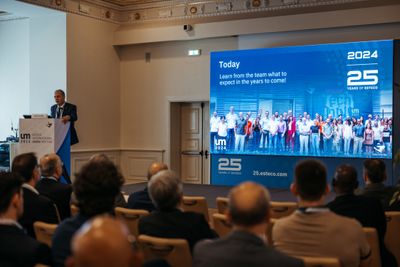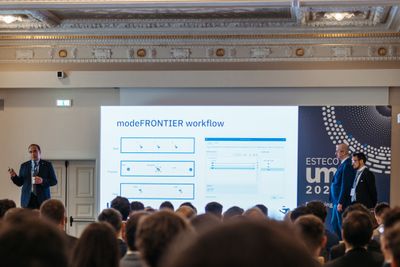ESTECO UM24: Delivering digital continuity for effective digital engineering
Written by Alessandro Viola
25 July 2024 · 5 min read


The theme of our 2024 International Users' Meeting is "Delivering digital continuity". End-to-end process automation, from simulation workflows to high-level business decisions, is key for effective digital engineering. This isn't a promise. At ESTECO, this is what we deliver.
45 speakers from companies as diverse as Toyota, Eaton, Leonardo, Daiwa House, CT Ingenierie, Fincantieri and Luna Rossa Challenge addressed the challenges in simulation-driven design in different ways using ESTECO VOLTA and modeFRONTIER software solutions. Our Users’ Meeting coincided with the 25th anniversary of the foundation of ESTECO. We had the pleasure of celebrating our first quarter century with more than 180 users and partners.

4 Takeaways from the ESTECO International Users’ Meeting 2024
1. From manual to AI-driven, collaborative digital engineering design processes
The unveiling of our modeFRONTIER and VOLTA software updates was one of the highlights of the meeting. Investments in AI data-driven modeling and automation of engineering design processes are increasing. Attendees were excited to learn about how the power of AI and Python programming language can help to streamline simulations and boost engineering efficiency with modeFRONTIER.

modeFRONTIER and AI: one-stop shop for faster, smarter, and more effective design space analysis.
By seamlessly integrating Python scripting with modeFRONTIER, our users can customize workflows, data pipelines and unlock the full potential of their simulations. Likewise, we reaffirmed our commitment to bringing innovation to simulation-driven design product development in the latest release of the VOLTA digital engineering platform.

VOLTA shapes the future of digital engineering with a proprietary design system, cloud microservices architecture, and business process management technology.
At UM24 we announced that our design system, SOUL, is now public. This allows our users to leverage our design system to build custom verticalizations that match the VOLTA user experience across the entire platform.
VOLTA cloud microservices architecture ensures scalability and cost-effectiveness, enabling companies to adapt to future demands. Additionally, enabling hyperautomation with business process management (BPM) technology revolutionizes the way simulation workflows and engineering business processes are captured and automated.
2. Design Optimization at Mazda, IVECO Group and Luna Rossa Prada Pirelli
Chikara Kawamura, Assistant Manager at Technical Research Institute, Mazda Corporation, explained how they develop design guidelines for vehicle body shape to find the best trade-off between securing the occupant’s survival space in the event of collision and achieving weight reduction. To validate structural optimization results, they combined mechanical analysis and modeFRONTIER data mining approaches (Sensitivity Analysis, Self Organizing Map, Principal Component Analysis and Clustering).
On the topic of safety and crash in vehicle development, engineers at IVECO group presented a finite element model approach for the characterization of the mechanical properties of the spot weld by taking its deformation and failure into account. “Spot Weld characterization, which appears straightforward, has become a complex exercise requiring a very detailed and complex FE Model involving many variables. In this context, the use of a software like modeFRONTIER is mandatory. It allows us to perform automatic evaluation of several different designs to find the best solution” said Andrea Morello and Marco Barbi, respectively Senior CAE Analyst and Senior Structural Analyst at IVECO group.
Our users' varied engineering disciplines and industries contributed to another key insight from the event: the most versatile application of design optimization. This was particularly true for the presentation led by Martin Jacoby and Simone Bartesaghi, CFD specialists at Luna Rossa Challenge: “Aero-hydro CFD optimizations driven by modeFRONTIER applied to AC75 yacht Luna Rossa for the 37th America’s Cup”. With the help of ESTECO simulation process automation and design optimization technology, the team tested solutions and materials for their LEQ12 prototype, built and developed in-house at the Cagliari base on Sardinia’s southern coast, Italy.

3. Toyota, Eaton, Leonardo, CT-Ingenierie and Daiwa House adopt ESTECO VOLTA
Yoshio Fujita, CAE Staff Engineer at Toyota Motor Corporation, illustrated how they employed VOLTA digital engineering platform to create a user-friendly CAE process and minimize lead time. Specifically, they focused on transforming the evaluation process for improving body stiffness without increasing vehicle body mass. With VOLTA, they automate the CAE process and design space exploration strategy (DOE generation, CAE sampling, surrogate model generation, pareto front exploration). This methodology has allowed them to reduce the number of tools required for CAE operations and evaluate 50,000 cases of thickness in just one week.
Eaton's vision for digital design includes authoritative source of truth, integrated infrastructures, model-based engineering, intelligent automated design, and cloud computing and HPC hybrid computing infrastructure. Uyiosa Abusomwan, Senior Manager, explained how the VOLTA platform is a key enabler for intelligent design and automation. From AI & Generative Design of liquid-to-air heat exchangers with additive manufacturing constraints, to AI & Multi-physics parametric optimization and reduced order modeling of champ lighting, and orchestration of data and physics-informed AI models to automate the design of EV gears.

Regarding the adoption of ESTECO technology in the aerospace industry, Valeria Vercella, Research Fellow at Leonardo, stated that modeFRONTIER is already a well-established tool for performing single-discipline optimization. The preliminary design process of a high-speed aircraft typically involves many engineering disciplines and the interaction of several experts for the same simulation workflow. That’s why they’re currently working with ESTECO engineering support and professional services to combine the use of modeFRONTIER with VOLTA platform. This enables them to handle the different runs of a simulation workflow, keep track of model versioning, and enhance collaboration between different subject matter experts.
“To accelerate the development of a new hybrid propulsion technology for the OB-1 orbital launcher, the consortium formed by HyPr Space, Telespazio France and CT Ingenierie has decided to deploy the VOLTA platform to ensure a robust design process among partners” said Romain Ricciardi, Space System Engineer at CT Ingenierie. Having access to this digital engineering platform will be very helpful for the system engineering teams at HyPr Space and CT Ingenierie. They can expect to maximize the correct enterprise-wide flow of engineering data and make them available between partners. The sharing and updating of interdisciplinary engineering knowledge and simulation models will become effortless. And, the modeFRONTIER design optimization technology tightly integrated in the VOLTA platform will enable them to automate the simulations and optimize the design efficiently and faster rather than working independently.
Our users have adopted VOLTA in fields beyond automotive and aerospace. As an example, Daiwa House, the largest construction company in Japan, needed a simulation process and data management (SPDM) and optimization system to conduct structural design and calculations more efficiently and effectively. Yuji Kogame, Construction & Building Information Modeling (BIM) Promotion Department - Technology Coordination Department Engineer at Daiwa House, clarified that linking their BIM platform with VOLTA helps them to perform more structural analysis in less time, analyze optimal designs and share results with project members and supervisors,and share the results with project members and supervisors in a common collaborative web environment.
4. The voice of our customers: The role of ESTECO Technology at Toyota, Brandenburg University of Technology and Air Liquide
UM24 also offered an invaluable opportunity to engage with our users from both industry and academia, strengthening relationships and paving the way for future collaborations. These interactions enabled us to gain insights into how our VOLTA and modeFRONTIER software solutions are perceived and used in the industry. In particular, we had a chat with some of our long-lasting customers, here are some of their thoughts.
Shigeki Kojima, Advanced Product Development Div at Toyota Motor Corporation, said “we consider modeFRONTIER and VOLTA as effective tools for solving technical issues and achieving CAE democratization in various departments such as crash, NVH, powertrain, multi-body dynamics and body design. modeFRONTIER allows us to integrate and automate various simulation solvers and use for design optimization. VOLTA automates time-consuming CAE processes. From DOE and surrogate models creation to exploration of pareto front, post-process and visualization of simulation results. This enables a wider audience of our engineers to perform vehicle performance trade-off studies more easily. Finally, we believe that ESTECO Technology for design optimization, CAE automation and simulation process and data management is necessary to achieve our company’s goal: deliver better vehicles to our customers as quickly as possible.”
BTU Cottbus-Senftenberg academic researcher Tim Franken brought his experience with modeFRONTIER over the last decade. “ESTECO supports you in learning and using modeFRONTIER for your research tasks just like an industrial customer would. Previously, everything was done by hand. I had to calculate the process manually with respective simulation tools, merge those results and maybe I got some good outcome based on some empirical knowledge. By using modeFRONTIER, I can implement my code, couple it with different simulation tools, set up the simulation run easily, and choose the best algorithm to use for multi-objective optimization of my energy system. ESTECO is also open to collaborating on scientific research projects as a software provider. This is a big advantage because often universities don’t have so many capabilities in implementing sophisticated simulation software and processes. ESTECO as a partner can elevate the quality of research projects quite a lot in order to achieve proper research outputs”.
“modeFRONTIER is an excellent software to combine material and process-based simulations for computational chemistry. It allows us to shorten the time for exploring all possible solutions and take informed decisions for developing and delivering technical and medical gas to a lot of our customers” according to Pluton Pullumbi - Air Liquide International Fellow at Air Liquide France.
Our next Users' Meetings will take place in 2025 and 2026 in the US and Italy respectively. In the meantime, if you want access to the proceedings and gain more insights on customer presentations, like CT Ingénierie, Eaton, Fincantieri, IVECO, Luna Rossa Challenge, Mazda and Pipistrel, please contact us at marketing@esteco.com.
Discover more about 25 years of experience enabling innovators to transform their products and processes.
Celebrate 25 years of looking to the future
Discover more about 25 years of experience enabling innovators to transform their products and processes.
Celebrate 25 years of looking to the future
Discover more about 25 years of experience enabling innovators to transform their products and processes.


